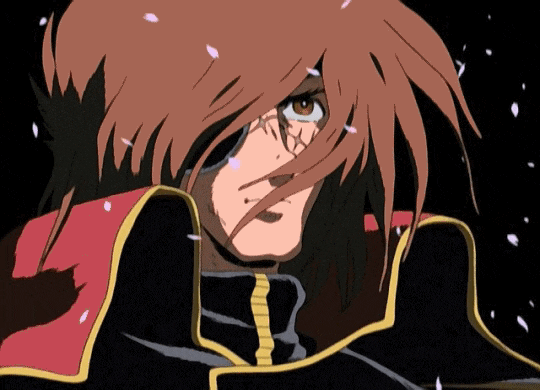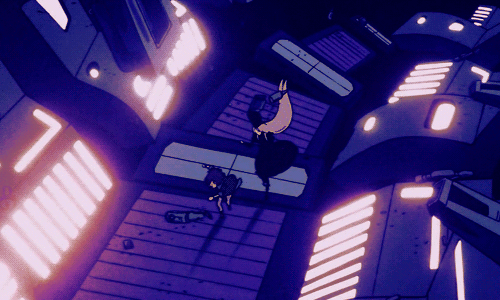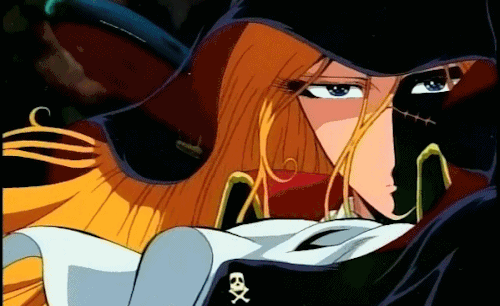originally posted at https://canmom.tumblr.com/post/710076...
Tragically there is a death in the news this week: Leiji Matsumoto, renowned creator of Space Battleship Yamato, Captain Harlock, and Galaxy Express 999. I’d like to commemorate him with an Animation Night…

It would be hard to think of a scifi mangaka or anime director more influential than Matsumoto beyond, well, Osamu Tezuka himself. Sure, Tomino, Anno, Rintaro - but who were they influenced by? Space Battleship Yamato is the bridge from goofy monster-of-the-week super robots to the dramatic anime that would eventually develop in the 80s onwards. So let’s start there.
As recounted in some detail here, Leiji Matsumoto grew up during the second world war; he struggled to find much of an audience for many years until his Senjō WWII manga started to become popular in 1971. This led, in turn, to Matsumoto joining the Space Battleship Yamato project in 1973 alongside producer Yoshinobu Nishizaki, and Eiichi Yamamoto of (no seriously) the ‘Animerama’ trilogy of erotic films, notably Belladonna of Sadness.
When Matsumoto joined the project, the plan was for it to be a dark ‘Lord of the Flies in space’ space drama. Matsumoto was at this time a WWII mangaka, so with WWII on the brain, it’s not entirely surprising that he drew most of his ideas from the war. It was his idea to design the spaceship after the actual battleship Yamato, a major symbol of Imperial Japan that in fact did very little before she was sunk in 1945.

Space Battleship Yamato shows a spaceship built in the ruined shell of the battleship, sailing around in space to fight against an alien invasion. It is armed with a superweapon called the ‘Wave Motion Cannon’ (波動砲 hadōhō), which became a standard term for a huge scifi laser weapon. Matsumoto planned to pattern events in the series after real battles in the world war. But the production was cut down, from 52 episodes to 26, and the story simplified, losing a lot of the antagonist’s motivation. Even so, it was a lot more complex than TV anime at the time was used to, a first step on the path to the complex, dark sci-fi anime and manga of the 80s and 90s.
The TV series struggled for ratings until the release of a compilation film in 1977, which kicked off a surge of ‘Yamato fever’. Its character archetypes, like the gruff paternal bridge captain, became stock characters. And while for most part the animation in the series was limited, it was an opportunity for Kazuhide Tomonoga to create some landmark mechanical animation of the sinking of the original Yamato.
Yamato was among the earliest wave of anime to be released outside of Japan. It gaining a following in Europe, and in America it was retitled and edited as Star Blazers. Contemporary critics dismissed it as a poorly animated knockoff of Star Wars, yet it continued to snowball in popularity. You might spot nods to it in various places; Miyazaki put a wrecked Yamato in Nausicaa as a gesture against its militaristic themes.
And it’s hard not to see something almost ludicrously nationalistic in a story about a resurrected Japanese battleship defending the Earth against invaders in a way it couldn’t defend Japan during its actual operation. We might think of the scene in Grave of the Fireflies where Seita imagines his father sailing away on a mighty warship. Matsumoto’s later works would generally veer away from such themes towards more personal stories in the same wide, imaginative scifi setting.

Captain Harlock is a kind of ‘eternal warrior’ type figure; the above cited article compares him to the characters of Michael Moorcock. He’s based on a character created by Matsumoto in highschool, and indeed he is kind of chuuni as a character: he’s a badass space pirate with a skull and crossbones and a cool scar and a swishy cloak. But Matsumoto was way ahead of the game with these motifs, and before long he got the opportunity to give Harlock his own show… at Toei.
But Matsumoto was finished in the director’s chair. He’d write the manga, and Rintaro (c.f. Animation Night 134) would get to direct it, drawing on his time under the wing of Dezaki. Harlock was an enormous success, one of the defining anime of the 70s, wildly popular in Europe as well as Albator.
Harlock spawned numerous TV series - for our purpose the notable one is Arcadia of my Youth (1982), which serves as a kind of prequel to the series with the origin story of Captain Harlock. What better place to begin than the beginning? Its director, Tomoharu Katsumata, is otherwise known for adapting many of Go Nagai’s works to film. The story sets up Harlock as belonging to a lineage that belongs on Earth with pilots called Phantom F. Harlock I/II, setting up the unsettling characterisation of Harlock II as fighting for the Nazis out of a sense of feudal obligation despite his misgivings towards the war.
This highlights the sort of strange tension that seems to exist in Matsumoto’s works. Many of his WWII-set stories are tragedies about pointless and futile deaths in war, featuring reluctant soldiers for the Axis who are not fascist ideologues but nevertheless fight for the cause. But he also likes to imagine that these figures could be redeemed and resurrected fight against the space imperialists. I imagine growing up in Imperial Japan during the war really does something to a person! Anyway I don’t know if I’m reading this right - I need to experience more of Matsumoto’s work to fully see if I think I understand what he’s going for, I think.
In any case, the enormous success of Harlock led to many further adaptations of Matsumoto’s manga such as Starzinger (Journey to the West in space), Danguard Ace (super robots), and ultimately of course Galaxy Express 999, a long bildungsroman about a boy who leaves Earth on a spacebound train - first as a TV anime and then the pair of movies directed by Rintaro in 1980 and 1981.
Compared to the somewhat formulaic TV series, the films were tight and compelling. By this time the renowned ‘charisma animator’ Yoshinori Kanada had really hit his stride, and was ready to essentially duel Tomonaga over who could create a more impressive depiction of a planet exploding into liquid fire, making Galaxy Express 999 not just an influential classic film but a real landmark of animation.

All of these scifi projects are closely tied in together; if you start digging with Matsumoto you start finding all sorts of intricate connections, characters recurring in different series, altogether comprising a ‘Leijiverse’. And of course in such a big body of work there are many recurring themes - conquering empires and mysterious women who are probably queen of somewhere. His most popular works, meanwhile, spawned remakes and sequels in abundance. Matsumoto became less central after these major successes, but continued to inspire anime productions - often at Toei and Madhouse - throughout the 90s. Read about them here if you’re curious!
One of the most surprising twists is the Daft Punk film Interstella 5555: The 5tory of the 5ecret 5tar 5ystem. The French duo had grown up watching adaptations of Matsumoto’s works on French TV, and when they decided to make a film to support their album, his style was a natural fit. So Matsumoto was called back up to Toei to supervise the film. We’ll talk more about this soon - I’m planning a music themed Animation Night, which was going to be tonight but I realised there’s more than enough Matsumoto here in its own right to fill out one of these so, hold on tight!!
The other note is The Cockpit (1993), a compilation OVA collecting three of Matsumoto’s WWII stories from the beginning of his career as envisioned by Madhouse star Yoshiaki Kawajiri, Takashi Imanishi and VOTOMS creator Ryōsuke Takashi. Although the animation style is much more 90s, it does serve as an illustration of the sort of stories that Matsumoto was telling with the WWII material.
All the stories focus on Axis soldiers; the first one sees a Luftwaffe pilot who deliberately allows Germany’s prototype atomic bomb to be destroyed by the enemy, the second on a kamikaze pilot fighting on the day of the atomic bombing; the third on a pair of Japanese soldiers in a futile race to reach an air base.

Tonight, then! We’ll be looking at the early parts of Leiji Matsumoto’s long career, in anticipation of visiting his later works down the line. That means starting with The Cockpit to see where Matsumoto himself started, then heading into Arcadia of My Youth to see the origins of Harlock. Which means yeah, we’re gonna be looking at a lot of Nazis and their planes tonight; if that’s a no-go I totally understand.
Animation Night 146 will be going live in about 10 minutes at 8pm UK time at twitch.tv/canmom - hope to see you there!
And rest in peace, Leiji Matsumoto.
Comments